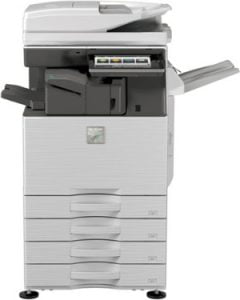Digital Photocopiers
Overview
Overview:
Digital Photocopiers
 Almost all photocopiers today are digital, as opposed to traditional analogue photocopiers. Digital photocopiers form a central part of every office, and as technology advances, their place in the office is becoming ever more integral. This article is going to look at the difference between the old and new technologies and explain the benefits of digital technology in the photocopying process.
Almost all photocopiers today are digital, as opposed to traditional analogue photocopiers. Digital photocopiers form a central part of every office, and as technology advances, their place in the office is becoming ever more integral. This article is going to look at the difference between the old and new technologies and explain the benefits of digital technology in the photocopying process.
What technology is used in an analogue photocopier?
Analogue photocopying involves the use of an internal mirror that copies the image of the document you want copying onto a drum. Using static electricity, the analogue photocopier uses toner particles to create an image of what is reflected onto the drum. It then uses heat and rollers to dry and fix the toner into place, and transfers it onto a new piece of paper.
What technology is used in a digital photocopier?
The document being photocopied on a digital copier is digitally scanned and saved into its memory. A laser is used to imprint the information on the drum, toner is applied, and the document is printed. The main difference between digital and analogue is that the document is saved to the memory, so the original document can then be scanned, or printed at another time in the future, without the need for the original document again.
Types of Digital Photocopiers
There are two types of digital photocopiers, ink-jet and laser. Midshire is a supplier of both these types of devices, through our photocopier brands: Sharp, HP, Lexmark and RISO.
Inkjet – An inkjet photocopier uses liquid ink during the printing process. They have print heads that spray ink onto the paper, rather than toner that is fused. The printing process tends to be a lot slower than laser printers, however they do have their place in the market for simple colour photocopying at low-volumes.
Laser – The majority of Midshire’s photocopier range falls into the laser category. Laser printers are both faster and produce better quality output. They also tend to be more reliable than inkjet printers.
Benefits of Digital Copiers
High Quality – users are able to edit the output of the document using the digital photocopier’s screen. If the original is dark, then the user can increase the exposure. Additionally, digital photocopiers can optimise the output for just text based or image based documents that are going to be photocopied. This can ensure that the photocopy is as close in quality to the original as possible.
Space Saving – Most digital photocopiers today are multifunction devices, allowing users to not only photocopy, but also scan, print and fax documents, meaning you no longer need 4 separate devices.
Efficiency – Digital photocopiers have a faster output speed than analogue devices, some print as fast as 120ppm!
Cheaper to run – there are many reasons why digital photocopiers are cheaper to run than analogue photocopiers. Firstly, analogue photocopiers are becoming few and far between, so parts for repairs are becoming scares, thus increasing their price. Secondly, as mentioned above, digital devices tend to be multifunctional, which reduces the need for ongoing support contracts on multiple devices. Additionally, with only one device you only need one set of toners, rather than various types of toner for each different device.
Environmentally friendly – Digital copiers are far more environmentally friendly compared to their analogue counterparts. Firstly, the actual photocopying technology means that the device only needs to commit to scanning the document once, reducing the amount of light energy required for the process. Technology advancements such as: automatic or timed shutdowns, sleep mode help to reduce their impact on the environment. Paper is also saved by the ability of digital photocopiers being able to duplex copies.
Speak to an Expert 03332 413 433
Remote Support
Our customer support help-desk technicians will guide you through the next steps,
to assist you with your query.
OneStop Login
(Formerly Callisto)

Search
